ASUS Ares. Performance
More recently, I talked about the ancient Greek god of war, who was lost in our difficult time, finding peace in the face of the game station ASUS Ares CG6155 .
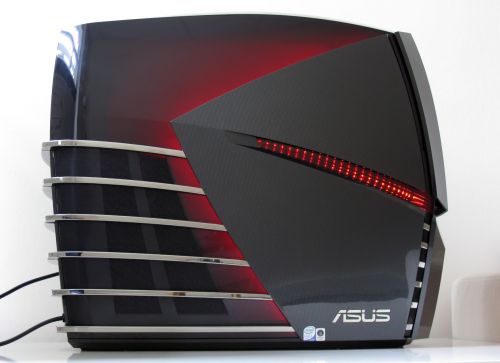
In the first part of a huge article there was a discussion about the diversified inner world of the inhabitants of Olympus and told that the beautiful young women-cybersprints from forZe approved Ares. Today we will talk about the capabilities of this specialized gaming computer. Traffic.
After the side cover of the “combat” case was removed, we get almost full access to its insides.
')
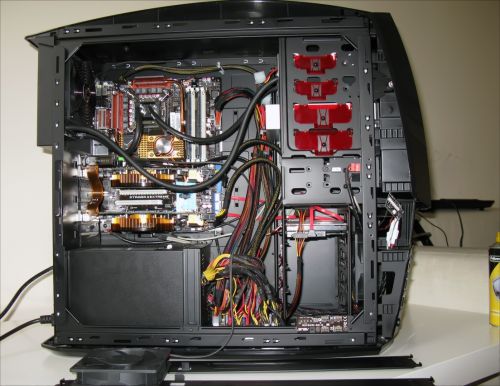
Despite the fact that there are quite a lot of all kinds of "stuffing" inside, everything is neatly laid out in its place, a lot of wires are braided into pigtails and neatly removed - nothing is confused, and you can not worry about getting sagging elements into moving parts.

The foundation of the functioning system is the ASUS Striker II Extreme motherboard based on NVIDIA nForce 790i Ultra .


I did not conduct a separate testing of the motherboard, but I was not too familiar with the tests on the Internet. At the same THG, this motherboard in its time received the highest scores in tests, for which it was awarded the “ Best of Tom's Hardware 2008 ” label. The motherboard supports 3-way SLI, DDR3 memory and has two eSATA ports, which the previous model lacked. The North Bridge has native support for PCI Express 2.0 without using a PCIe 1.0 to 2.0 bridge. The space around the socket is surrounded by a heat pipe design, which in theory can prevent the installation of heavy-duty coolers, but this model uses water cooling, so nothing interferes with the water block.
Included with the motherboard is a sound card ASUS SupremeFX II with all the necessary analog connectors, but the digital signal can be output directly from the motherboard via optical or coaxial connectors.
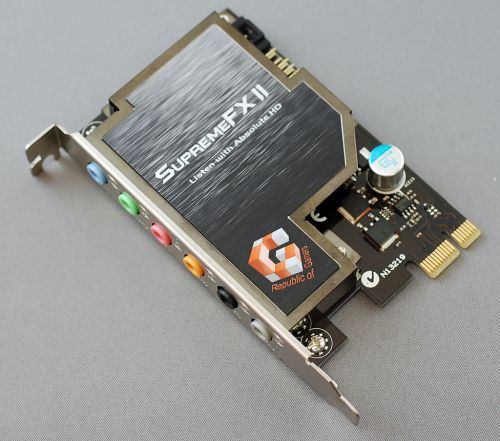
The ancient Greek god of war Ares approached the choice of weapons quite unusually - instead of morally obsolete swords and shields, he chose a modern quad-core Intel Core 2 Quad Q9450 processor and two NVIDIA GeForce 9800GT video cards in SLI mode. The quad-core silicon giant Intel Core 2 Quad Q9450 processor , made on 45-nanometer hafnium production technology, has a nominal clock frequency of 2667 MHz and a bus frequency of 1333 MHz .

The volume of L1 cache is 4 * 32Kb, and L2 is already 12 megabytes! The maximum rated power consumed by the processor is 95W, which can be a significant contributor to the "greenhouse" conditions inside the case, however, as I said, in this gaming station water cooling is used.
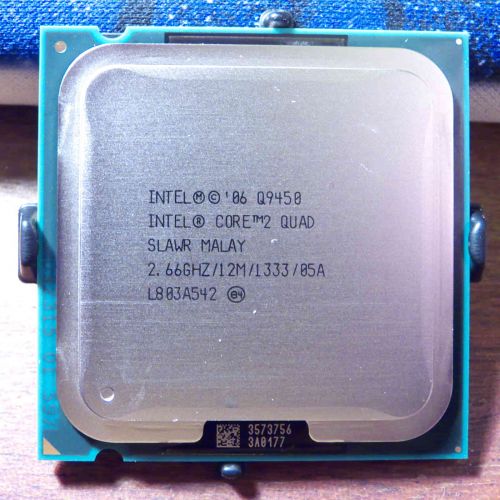
By the way, NWS failed to recognize, but apparently there is a lot in common with the systems from Thermaltake .
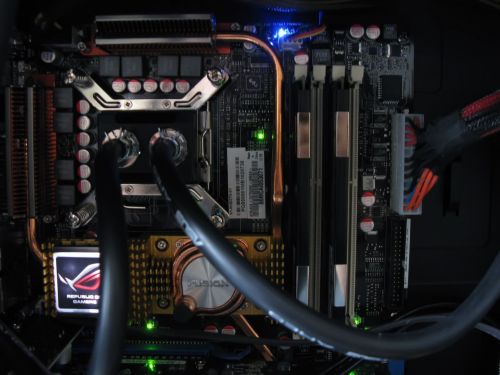
Two video cards of the 9th series of NVIDIA GeForce 9800GT , connected by a flexible jumper to the SLI system, in the manufacturer's calculation should provide decent performance in demanding three-dimensional applications. Each video card on its board has 1024MB of 256-bit GDDR3 memory. The core, shader and memory frequencies are 600, 1500 and 900 MHz respectively.
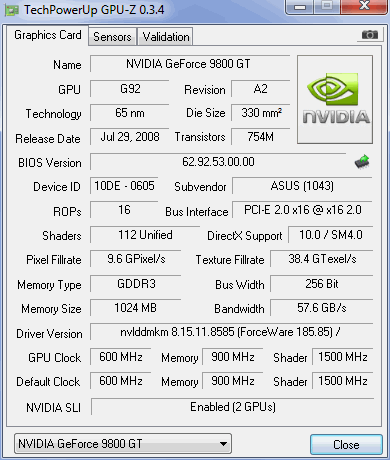
The motherboard has two DDR3 memory bars of 2048 MB each (you can insert 4 bars in total).
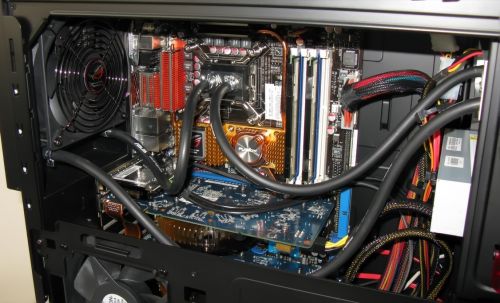
Obviously, the system is quite voracious, so a 300W power supply is not enough. In this case, use - attention! - two power supply units of 1000W each! Soothes only the fact that they are almost always not in full load. But what is the stock for upgrade! About power supplies are two blocks from Seventeam , model ST-1000E-AD . Hardly anyone has heard of such a manufacturer, but this is only because it is practically not exported to Russia. But TAM this manufacturer makes high-quality OEM products for such giants as CoolerMaster, SilverStone, Thermaltake and Zalman. Power supplies are painted black and have non-standard power connectors - good, the power cords are included.
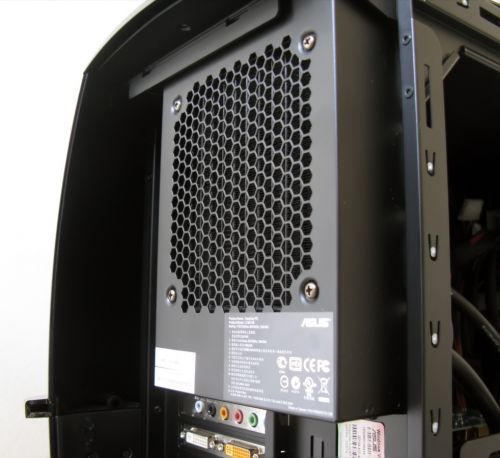
This assembly uses a single 500GB Hitachi HDP725050GLA hard drive, which is probably not enough for our times. But the upgrade has not been canceled.
For testing the computer used Samsung SyncMaster 245B monitor with a diagonal of 24 ”and a maximum resolution of 1920x1200.
Mahmud, set fire!
You press the cherished touch button on the front panel, and immediately heard the hum from numerous coolers somewhere in the depths of creation in armor. The unusual red light distracts the main attention, which is why the first loading of the operating system flies almost imperceptibly. By the way, this Vista was installed Windows Vista Home Premium .
A little more attention has already been paid to reloading - it really passes very quickly.
The first thing I did was install Adobe Photoshop CS4 to process 12-megapixel monster photos for the article. It's funny, but everything about everything took exactly 4 minutes, which I was pleasantly surprised. I launch, drag and drop a couple of photos - resizing, color correction, filters, and in general, any actions take place absolutely without delay (on my home computer I can safely go to make coffee when a 6-megabyte photo is used, for example, the Imagenomic Noiseware filter). The mood has improved, we go further.
The next stage of testing was the installation of the game Crysis Warhead , the disc of which was purchased a day before the descent of the god of war from Olympus to mere mortals.

First, I set the maximum requirements - 1920x1200 resolution, anti-aliasing, blur, etc. I start - it slows down :) Or rather, you can play, but it's difficult - I ran 10 minutes in order to just look at the crisis beauty.
The joy of the game was complete with a lower resolution (1600x1200) and a decrease in the degree of smoothness - here it was really all without brakes, but with still decent graphics. During operation, the rear wall of the computer was warm enough, which was felt even at a distance of a meter. The game did not go through, but there were plenty of them. Crysis Warhead Benchmark version 1.0.0.0 at a resolution of 1920x1200 (HD Widescreen) produced a maximum of 25FPS, a minimum of 14 and an average of 19.

Well, in order not to be completely subjective, I will share the “parrots” from synthetic tests that were also launched on the gaming station. Drivers - NVIDIA 185.85, Nvidia PhysX 9.09.0428, 3DMark 05, 3DMark 06, 3DMark Vantage and SuperPi were used from the tests.
Pi was calculated to one million decimal places and took 17.643 seconds.

For comparison, the current world record (from our friend DeDaL ) is 6.750 seconds, but that was achieved on an Intel Core2Duo E8600 processor with a frequency of 6,600 MHz ! Systems on Intel Core i7 without overclocking count up to a million in about 13-14 seconds.
At a resolution of 1920x1200 3DMark05 issued 16065 marks (the world record is 49943 and reached four (!) Radeon HD 4890).

3DMark06 yielded 12712 parrots (world record = 37834 )
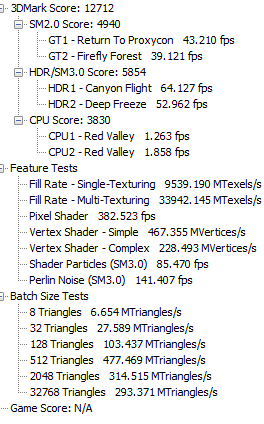
In the Performance-preset 3 DMarkvantage 1.0.1 gave the result in P10965 points (P = Performance, GPU - 9191, CPU - 26054). The world record is 40824 marks on two 295GTX, by the way, on the same motherboard that is installed in this assembly.

In the arithmetic test CPUFreeBenchmark 2.2 the result is more than worthy - 25.06 seconds.
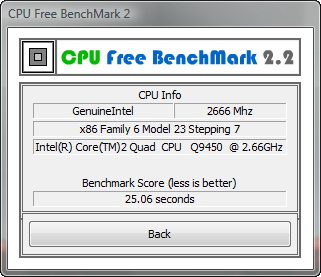
The HDTune 3.50 hard disk test yielded fairly good performance:

The maximum speed was 91Mb / s , the average - 79Mb / s ; random access time at very good low.

Strange, perhaps, that the temperature of the hard disk was not displayed - perhaps the temperature sensor inside the hard drive did not work, but to the touch the disk was not hot at all.
After all the tests, the temperature (in the OCCT 3.1.0 program) of the cores varied from 37 to 48 degrees, and the video cards warmed up to 61 and 72 degrees, respectively.

In order to make a conclusion about the performance of the ASUS Ares gaming station, you need to consider that it was designed in mid-2008, i.e. a year ago, and she came to the test just now. At that time, the performance of this computer was at a very high level, which is not quite true a year later, in the era of gigantic powers of the flagship Intel Core i7 processors and 295GTX heaters. Secondly, it is worth considering that I am telling you about the simplest version of the “god”, which is sold almost at the stock price of about 60+ thousand rubles. If you collect exactly the same equipment yourself, separately for the components, you can save a little bit, but such an elegant appearance will not work.
Since we started talking about pickings, I’ll tell you about Ares’s older brother (oddly enough, they are namesakes, but they are distinguished by postscript ( Performance and Flagship, respectively).
In the version of Flagship (“ flagship ”), the stuffing is more robust - the Intel Core2 Extreme QX9650 processor, three NVIDIA GeForce GTX280 video cards in the 3-Way SLI mode, 8 gigabytes of DDR3 memory (1333 MHz), 4TB of disk space and other Windows Vista Ultimate. It costs, respectively, more expensive - the price can reach 150 thousand rubles. Is it a lot or a little? Look at reviews on reputable iron sites, where almost every month game configurations are assembled and everything will become clear. Immediately, among other things, you get a unique elegant case (which you are not ashamed to put on the most visible place), many years of comprehensive support, a licensed operating system and other pleasant trifles.
pros
- The richest grade;
- Stylish aggressive look;
- Perfect build quality and careful selection of components;
- High performance;
- Opportunities for upgrade;
- Adequate price (60 thousand rubles).
Minuses
- Huge weight (45 kg)
- Windows Home Premium 32bit included;
- High power consumption;
- Enough noisy power supplies;
- Small in size (500GB) hard drive.
I think ASUS did manage to please both categories of users - gamers and overclocker enthusiasts, by providing a beautiful (from the point of view of modding) and a functional training ground for performance.
Perhaps somewhere there is a small unclaimed brute force - for example, in two power units (1000 watts each) and in the water cooling system, which could be replaced by equally reliable, but cheap and silent components. But in general, a very worthy fusion of high technologies has turned out - the system is very well thought out, assembled and balanced.
Performance at a very high level and will be able to please, perhaps, the most experienced user. Looking further, we can safely say that for some time the user of such a computer will be able to gain a decent overclocking potential of the system, and even further, an excellent filling and a thoughtful body, which are designed for any upgrade, will come in handy. Perhaps, by the way, it was for this purpose that they inserted two power supplies from Seventeam; ITS and reliable power supplies are the key to stability.
So, dear gamers, you can safely trust the ASUS brand, which, releasing RoG-components, was not afraid to make a gaming station, and in this matter achieved absolute success.
As promised - video with the girls champions in CS ( forZe team), who helped to contribute to the assessment of the "gameability" of the computer. I agree, Counter Strike is not the most demanding game, but we didn’t have champions for the same crisis;) By the way, they really liked the device, first of all because of their appearance. I also liked the keyboard ... but they rejected the mouse (although they liked the idea of weights) - as it should be, they ran the mouse from Razer, which they took with them :) Pay attention to what elegant headshots the girls make!
If you want, I can tell you in a separate post about the keyboard and headphones that came with Ares.
Successes!

In the first part of a huge article there was a discussion about the diversified inner world of the inhabitants of Olympus and told that the beautiful young women-cybersprints from forZe approved Ares. Today we will talk about the capabilities of this specialized gaming computer. Traffic.
After the side cover of the “combat” case was removed, we get almost full access to its insides.
')

Despite the fact that there are quite a lot of all kinds of "stuffing" inside, everything is neatly laid out in its place, a lot of wires are braided into pigtails and neatly removed - nothing is confused, and you can not worry about getting sagging elements into moving parts.

The foundation of the functioning system is the ASUS Striker II Extreme motherboard based on NVIDIA nForce 790i Ultra .


I did not conduct a separate testing of the motherboard, but I was not too familiar with the tests on the Internet. At the same THG, this motherboard in its time received the highest scores in tests, for which it was awarded the “ Best of Tom's Hardware 2008 ” label. The motherboard supports 3-way SLI, DDR3 memory and has two eSATA ports, which the previous model lacked. The North Bridge has native support for PCI Express 2.0 without using a PCIe 1.0 to 2.0 bridge. The space around the socket is surrounded by a heat pipe design, which in theory can prevent the installation of heavy-duty coolers, but this model uses water cooling, so nothing interferes with the water block.
Included with the motherboard is a sound card ASUS SupremeFX II with all the necessary analog connectors, but the digital signal can be output directly from the motherboard via optical or coaxial connectors.

The ancient Greek god of war Ares approached the choice of weapons quite unusually - instead of morally obsolete swords and shields, he chose a modern quad-core Intel Core 2 Quad Q9450 processor and two NVIDIA GeForce 9800GT video cards in SLI mode. The quad-core silicon giant Intel Core 2 Quad Q9450 processor , made on 45-nanometer hafnium production technology, has a nominal clock frequency of 2667 MHz and a bus frequency of 1333 MHz .

The volume of L1 cache is 4 * 32Kb, and L2 is already 12 megabytes! The maximum rated power consumed by the processor is 95W, which can be a significant contributor to the "greenhouse" conditions inside the case, however, as I said, in this gaming station water cooling is used.

By the way, NWS failed to recognize, but apparently there is a lot in common with the systems from Thermaltake .

Two video cards of the 9th series of NVIDIA GeForce 9800GT , connected by a flexible jumper to the SLI system, in the manufacturer's calculation should provide decent performance in demanding three-dimensional applications. Each video card on its board has 1024MB of 256-bit GDDR3 memory. The core, shader and memory frequencies are 600, 1500 and 900 MHz respectively.

The motherboard has two DDR3 memory bars of 2048 MB each (you can insert 4 bars in total).

Obviously, the system is quite voracious, so a 300W power supply is not enough. In this case, use - attention! - two power supply units of 1000W each! Soothes only the fact that they are almost always not in full load. But what is the stock for upgrade! About power supplies are two blocks from Seventeam , model ST-1000E-AD . Hardly anyone has heard of such a manufacturer, but this is only because it is practically not exported to Russia. But TAM this manufacturer makes high-quality OEM products for such giants as CoolerMaster, SilverStone, Thermaltake and Zalman. Power supplies are painted black and have non-standard power connectors - good, the power cords are included.

This assembly uses a single 500GB Hitachi HDP725050GLA hard drive, which is probably not enough for our times. But the upgrade has not been canceled.
For testing the computer used Samsung SyncMaster 245B monitor with a diagonal of 24 ”and a maximum resolution of 1920x1200.
Mahmud, set fire!
You press the cherished touch button on the front panel, and immediately heard the hum from numerous coolers somewhere in the depths of creation in armor. The unusual red light distracts the main attention, which is why the first loading of the operating system flies almost imperceptibly. By the way, this Vista was installed Windows Vista Home Premium .
A little more attention has already been paid to reloading - it really passes very quickly.
The first thing I did was install Adobe Photoshop CS4 to process 12-megapixel monster photos for the article. It's funny, but everything about everything took exactly 4 minutes, which I was pleasantly surprised. I launch, drag and drop a couple of photos - resizing, color correction, filters, and in general, any actions take place absolutely without delay (on my home computer I can safely go to make coffee when a 6-megabyte photo is used, for example, the Imagenomic Noiseware filter). The mood has improved, we go further.
The next stage of testing was the installation of the game Crysis Warhead , the disc of which was purchased a day before the descent of the god of war from Olympus to mere mortals.

First, I set the maximum requirements - 1920x1200 resolution, anti-aliasing, blur, etc. I start - it slows down :) Or rather, you can play, but it's difficult - I ran 10 minutes in order to just look at the crisis beauty.
The joy of the game was complete with a lower resolution (1600x1200) and a decrease in the degree of smoothness - here it was really all without brakes, but with still decent graphics. During operation, the rear wall of the computer was warm enough, which was felt even at a distance of a meter. The game did not go through, but there were plenty of them. Crysis Warhead Benchmark version 1.0.0.0 at a resolution of 1920x1200 (HD Widescreen) produced a maximum of 25FPS, a minimum of 14 and an average of 19.

Well, in order not to be completely subjective, I will share the “parrots” from synthetic tests that were also launched on the gaming station. Drivers - NVIDIA 185.85, Nvidia PhysX 9.09.0428, 3DMark 05, 3DMark 06, 3DMark Vantage and SuperPi were used from the tests.
Pi was calculated to one million decimal places and took 17.643 seconds.

For comparison, the current world record (from our friend DeDaL ) is 6.750 seconds, but that was achieved on an Intel Core2Duo E8600 processor with a frequency of 6,600 MHz ! Systems on Intel Core i7 without overclocking count up to a million in about 13-14 seconds.
At a resolution of 1920x1200 3DMark05 issued 16065 marks (the world record is 49943 and reached four (!) Radeon HD 4890).

3DMark06 yielded 12712 parrots (world record = 37834 )

In the Performance-preset 3 DMarkvantage 1.0.1 gave the result in P10965 points (P = Performance, GPU - 9191, CPU - 26054). The world record is 40824 marks on two 295GTX, by the way, on the same motherboard that is installed in this assembly.

In the arithmetic test CPUFreeBenchmark 2.2 the result is more than worthy - 25.06 seconds.

The HDTune 3.50 hard disk test yielded fairly good performance:

The maximum speed was 91Mb / s , the average - 79Mb / s ; random access time at very good low.

Strange, perhaps, that the temperature of the hard disk was not displayed - perhaps the temperature sensor inside the hard drive did not work, but to the touch the disk was not hot at all.
After all the tests, the temperature (in the OCCT 3.1.0 program) of the cores varied from 37 to 48 degrees, and the video cards warmed up to 61 and 72 degrees, respectively.

In order to make a conclusion about the performance of the ASUS Ares gaming station, you need to consider that it was designed in mid-2008, i.e. a year ago, and she came to the test just now. At that time, the performance of this computer was at a very high level, which is not quite true a year later, in the era of gigantic powers of the flagship Intel Core i7 processors and 295GTX heaters. Secondly, it is worth considering that I am telling you about the simplest version of the “god”, which is sold almost at the stock price of about 60+ thousand rubles. If you collect exactly the same equipment yourself, separately for the components, you can save a little bit, but such an elegant appearance will not work.
Since we started talking about pickings, I’ll tell you about Ares’s older brother (oddly enough, they are namesakes, but they are distinguished by postscript ( Performance and Flagship, respectively).
In the version of Flagship (“ flagship ”), the stuffing is more robust - the Intel Core2 Extreme QX9650 processor, three NVIDIA GeForce GTX280 video cards in the 3-Way SLI mode, 8 gigabytes of DDR3 memory (1333 MHz), 4TB of disk space and other Windows Vista Ultimate. It costs, respectively, more expensive - the price can reach 150 thousand rubles. Is it a lot or a little? Look at reviews on reputable iron sites, where almost every month game configurations are assembled and everything will become clear. Immediately, among other things, you get a unique elegant case (which you are not ashamed to put on the most visible place), many years of comprehensive support, a licensed operating system and other pleasant trifles.
Check weighing
pros
- The richest grade;
- Stylish aggressive look;
- Perfect build quality and careful selection of components;
- High performance;
- Opportunities for upgrade;
- Adequate price (60 thousand rubles).
Minuses
- Huge weight (45 kg)
- Windows Home Premium 32bit included;
- High power consumption;
- Enough noisy power supplies;
- Small in size (500GB) hard drive.
findings
I think ASUS did manage to please both categories of users - gamers and overclocker enthusiasts, by providing a beautiful (from the point of view of modding) and a functional training ground for performance.
Perhaps somewhere there is a small unclaimed brute force - for example, in two power units (1000 watts each) and in the water cooling system, which could be replaced by equally reliable, but cheap and silent components. But in general, a very worthy fusion of high technologies has turned out - the system is very well thought out, assembled and balanced.
Performance at a very high level and will be able to please, perhaps, the most experienced user. Looking further, we can safely say that for some time the user of such a computer will be able to gain a decent overclocking potential of the system, and even further, an excellent filling and a thoughtful body, which are designed for any upgrade, will come in handy. Perhaps, by the way, it was for this purpose that they inserted two power supplies from Seventeam; ITS and reliable power supplies are the key to stability.
So, dear gamers, you can safely trust the ASUS brand, which, releasing RoG-components, was not afraid to make a gaming station, and in this matter achieved absolute success.
BONUS
As promised - video with the girls champions in CS ( forZe team), who helped to contribute to the assessment of the "gameability" of the computer. I agree, Counter Strike is not the most demanding game, but we didn’t have champions for the same crisis;) By the way, they really liked the device, first of all because of their appearance. I also liked the keyboard ... but they rejected the mouse (although they liked the idea of weights) - as it should be, they ran the mouse from Razer, which they took with them :) Pay attention to what elegant headshots the girls make!
If you want, I can tell you in a separate post about the keyboard and headphones that came with Ares.
Successes!
Source: https://habr.com/ru/post/68925/
All Articles